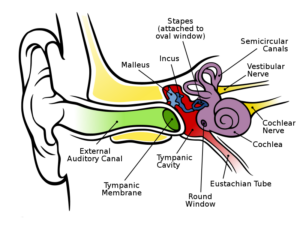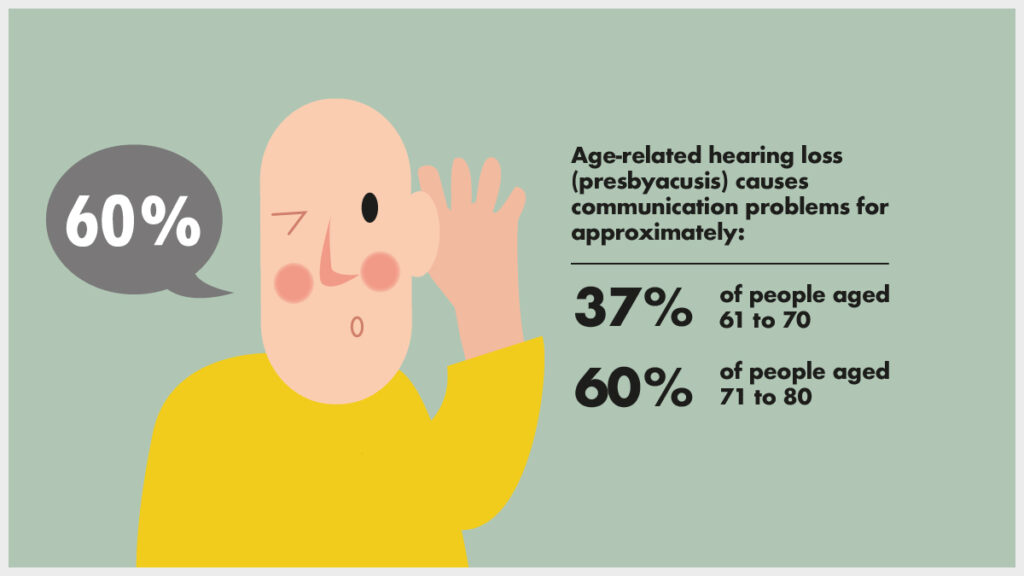
Age-related hearing loss affects almost all of us as we age. Good acoustics can promote not just hearing but also the ability to function and well-being.
A calm acoustic environment benefits all of us, whatever level of hearing we have, but it is particularly important for those with hearing impairments. The most common cause of hearing impairment is age-related hearing loss; poor or impaired hearing affects around a third of those aged 65 and two-thirds of those aged 75.
In practice, age-related hearing loss is irreversible hearing damage that progresses gradually as we age. At varying levels, it can restrict the ability to function from a minor to a major extent.
Interview with Anne Viljanen, Doctor of Health Sciences and senior lecturer at the University of Jyväskylä.

Generally, it is the ability to hear high-pitched noises that deteriorates first, no longer being able to hear bird songs or grasshoppers chirping. As hearing damage progresses, the ability to hear lower-pitched frequencies and speech also deteriorates. Certain consonants are the first to disappear from speech, generally those spoken at a higher pitch.
Viljanen.
Age-related hearing loss usually happens due to the deterioration of the hearing cells of the inner ear or the cochlear nerve. Poor hearing in elderly people is most often due to hearing loss, but there can also be other factors at play.
We don’t live our lives in a protective bubble, and the environment around us is constantly full of different sounds and exposure agents. Our hearing is the result of the combination of our genotype and all the environmental factors we have been exposed to in our lives. For this reason, it can be difficult to determine the impact of a single factor in the development of age-related hearing loss.
Viljanen.
Hearing is related to our physical, social and psychological wellbeing.

Whilst hearing is an important sense when it comes to our wellbeing and ability to function, its importance is not always taken into consideration.
“Hearing is an important sense for us, helping us to observe the environment around us,” states Viljanen. For example, the sound of an approaching car helps pedestrians to avoid it, and the familiar sound of an incoming call tells us to answer the phone.
Poor hearing in the elderly can lead to social isolation and in turn to depression. The link between hearing impairment and mobility challenges and memory problems is also being investigated.
“Impaired hearing and the communication issues it causes can lead to not being able to keep up with conversations or struggling when listening. There is then the risk of the elderly person starting to avoid places where it is difficult to hear, and ending up not going out at all.”
In terms of aging related hearing loss, the most challenging places are those with lots of background noise, where sound reverberates, or where there are lots of sources of noise. These kinds of spaces include train stations with their announcements or noisy cafés.

Good acoustics should increase the comfort and ability to function of those with impaired hearing, as well as making it easier to go about daily tasks and feel safe. In noisy environments the risk is that useful information, such as announcements or emergency alarms, can get lost amongst other noises.
Understanding and good acoustics support those with age-related hearing loss
There are three elements that need to be taken into account when seeking to resolve hearing challenges:
- the listener themselves
- the person or people they are talking with
- the environment
The person with the impaired hearing must understand their age-related hearing loss and the challenges it brings, and they must also be willing and motivated to use hearing aids, for example.

“The person they are talking with must also be aware of the hearing impairment and support the needs of the person with the hearing impairment by choosing calmer environments for their discussions. Instead of having to raise your voice excessively when talking, think about maintaining eye contact, speaking slower, and articulating clearly, however do not over exaggerate,” Viljanen suggests.
According to Viljanen, awareness and understanding of age-related hearing loss does exist, and there are all kinds of aids available to support those with hearing impairments. However, one area where challenges can arise when it comes to age-related hearing loss is attitudes, with some considering impaired hearing to be a given with aging, believing that nothing can be done about it.
It is, however, worth remembering that listening or at least communicating can help, even if hearing impairments cannot be cured. Hearing aids are one such good aid that improves quality of life. In public spaces induction loops are also an option, conveying the speaker’s voice directly into a hearing aid. Viljanen.
Using other senses to support hearing is important. Good, indirect lighting helps those talking maintain eye contact and visual signs can help people orientate themselves in noisy train stations, for example.
When it comes to environments, the provision of acoustics that support hearing should be ensured. Acoustic ceilings and acoustic adaptation of wall surfaces reduce reverberation and improve the clarity of speech.
As our population structure changes, there are more and more elderly people, and as such, our need for hearing friendly spaces is growing. The acoustics and acoustic environment must also be taken into account when designing all public spaces.
_________________________________________________________________________

